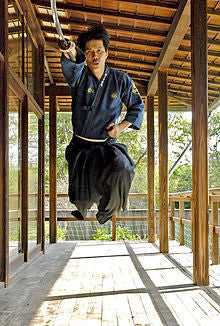Votre panier est vide


Traditional Japanese martial arts isn't restricted simply to attack-based combat and swordsmanship. Iaijutsu is a lesser-known style of Japanese martial arts that focuses specifically on sword-drawing. It's centered around speed, encouraging practitioners to draw their sword in a fast and efficient manner.
According to the book Japanese Swordsmanship: Technique and Practice, iaijutsu is typically performed as a combative sword-drawing practice. However, it can also be performed for defensive purposes, such as countering an opponent's attack.
Postures
The way in which a practitioner of iaijutsu positions him or herself plays a key role in their ability to draw a sword in an efficient manner. With that said, there are two postures particularly effective for this practice. The first postures involves a low crouching stance (ia-goshi), while the second posture involves standing (tachi-ai).
There's also a seated posture (tate-hiza), though it's rarely used in iaijutsu because of its limited mobility. Seiza is another alternative posture, which involves a formal kneeling stance. Like the seated posture, however, seiza typically isn't used in iaijutsu because it restricts the practitioner's movements.
Iaijutsu and the Japanese Swords
It's important to understand the way in which Japanese swords are worn, as this affects iaijutsu. In response to the Mongol invasion, Japanese swordsmiths began crafting the tachi sword with a slight curve. Because the curve was closed to the hilt, however, it was best worn with the cutting-edge facing down.
When the Japanese produced the uchigatana -- the katana's predecessor -- swordsmiths made the curve closer to the striking tip. Because of this change, the uchigatana was worn with the cutting edge facing up. And when the katana was invented, it too followed this same configuration, with samurai warriors wearing it with the cutting edge facing up.
So, for what reasons did Japanese samurai warriors wear swords like the katana and uchigatana with the cutting edge facing up? For starters, it reduced unnecessary wear on the blade. Wearing a sword with the cutting edge facing down allowed gravity to "push" the blade into the scabbard, causing it to dull more quickly. Secondly, wearing a sword with the cutting edge facing down increased the risk of accidentally injury to the wearer.
Arguably, the most significant reason why swords like the katana and uchigatana were worn with the cutting edge facing up is because it allowed for faster drawing, which is the fundamental goal of iaijutsu.
Hopefully, this gives you a better understanding of Japanese iaijutsu.